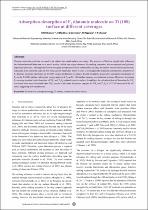 ResearchSpace
ResearchSpace
Adsorption-desorption of F2 diatomic molecule on Ti (100) surface at different coverages
JavaScript is disabled for your browser. Some features of this site may not work without it.
- ResearchSpace
- →
- Research Publications/Outputs
- →
- Journal Articles
- →
- View Item
| dc.contributor.author |
Tshwane, David M

|
|
| dc.contributor.author |
Modiba, Rosinah

|
|
| dc.contributor.author |
Govender, Gonasagren

|
|
| dc.contributor.author |
Ngoepe, PE

|
|
| dc.contributor.author |
Chauke, HR

|
|
| dc.date.accessioned | 2023-03-08T08:58:07Z | |
| dc.date.available | 2023-03-08T08:58:07Z | |
| dc.date.issued | 2021-12 | |
| dc.identifier.citation | Tshwane, D.M., Modiba, R., Govender, G., Ngoepe, P. & Chauke, H. 2021. Adsorption-desorption of F2 diatomic molecule on Ti (100) surface at different coverages. <i>South African Journal for Science and Technology, 40(1).</i> http://hdl.handle.net/10204/12648 | en_ZA |
| dc.identifier.issn | 0254-3486 | |
| dc.identifier.issn | 2222-4173 | |
| dc.identifier.uri | https://doi.org/10.36303/SATNT.2021cosaami.38 | |
| dc.identifier.uri | http://hdl.handle.net/10204/12648 | |
| dc.description.abstract | Fluorine molecules and ions are used as an etchant for metal surface processing. The presence of fluorine significantly influences the electrochemical behaviour on a metal surface, which has major relevance for etching, corrosion, electro-catalysis and galvanic deposition processes. Although the fluorine ions play an important role in metal surface etching, the studies remain limited and unclear, especially at the atomistic scale. In this work, density functional theory is used to investigate the structural and electronic properties of F2 diatomic molecule adsorption on Ti (100) surface at different coverages. Results revealed a dissociative adsorption mechanism of F2 on the Ti (100) surface. Adsorption energy analysis of F2 on Ti (100) surface denotes an exothermic process. Moreover, increasing F2 coverage resulted in the formation of TiF4 and Ti2F6 molecules on the surface. In addition, the calculated heat of formation for TiF4 was found to be more favourable than Ti2F6 species. Calculated desorption energies for TiF4 and Ti2F6 is 11.73 eV/atom and 9.04 eV/atom, suggesting non-spontaneous. | en_US |
| dc.format | Fulltext | en_US |
| dc.language.iso | en | en_US |
| dc.relation.uri | https://journals.co.za/doi/abs/10.36303/SATNT.2021cosaami.38 | en_US |
| dc.source | South African Journal for Science and Technology, 40(1) | en_US |
| dc.subject | Fluorine ions | en_US |
| dc.subject | Fluorine molecules | en_US |
| dc.subject | Metal surface processing | en_US |
| dc.title | Adsorption-desorption of F2 diatomic molecule on Ti (100) surface at different coverages | en_US |
| dc.type | Article | en_US |
| dc.description.pages | 200–204 | en_US |
| dc.description.cluster | Manufacturing | en_US |
| dc.description.impactarea | Powder Metallurgy Technologies | en_US |
| dc.description.impactarea | Advanced Casting Technologies | en_US |
| dc.identifier.apacitation | Tshwane, D. M., Modiba, R., Govender, G., Ngoepe, P., & Chauke, H. (2021). Adsorption-desorption of F2 diatomic molecule on Ti (100) surface at different coverages. <i>South African Journal for Science and Technology, 40(1)</i>, http://hdl.handle.net/10204/12648 | en_ZA |
| dc.identifier.chicagocitation | Tshwane, David M, Rosinah Modiba, Gonasagren Govender, PE Ngoepe, and HR Chauke "Adsorption-desorption of F2 diatomic molecule on Ti (100) surface at different coverages." <i>South African Journal for Science and Technology, 40(1)</i> (2021) http://hdl.handle.net/10204/12648 | en_ZA |
| dc.identifier.vancouvercitation | Tshwane DM, Modiba R, Govender G, Ngoepe P, Chauke H. Adsorption-desorption of F2 diatomic molecule on Ti (100) surface at different coverages. South African Journal for Science and Technology, 40(1). 2021; http://hdl.handle.net/10204/12648. | en_ZA |
| dc.identifier.ris | TY - Article AU - Tshwane, David M AU - Modiba, Rosinah AU - Govender, Gonasagren AU - Ngoepe, PE AU - Chauke, HR AB - Fluorine molecules and ions are used as an etchant for metal surface processing. The presence of fluorine significantly influences the electrochemical behaviour on a metal surface, which has major relevance for etching, corrosion, electro-catalysis and galvanic deposition processes. Although the fluorine ions play an important role in metal surface etching, the studies remain limited and unclear, especially at the atomistic scale. In this work, density functional theory is used to investigate the structural and electronic properties of F2 diatomic molecule adsorption on Ti (100) surface at different coverages. Results revealed a dissociative adsorption mechanism of F2 on the Ti (100) surface. Adsorption energy analysis of F2 on Ti (100) surface denotes an exothermic process. Moreover, increasing F2 coverage resulted in the formation of TiF4 and Ti2F6 molecules on the surface. In addition, the calculated heat of formation for TiF4 was found to be more favourable than Ti2F6 species. Calculated desorption energies for TiF4 and Ti2F6 is 11.73 eV/atom and 9.04 eV/atom, suggesting non-spontaneous. DA - 2021-12 DB - ResearchSpace DP - CSIR J1 - South African Journal for Science and Technology, 40(1) KW - Fluorine ions KW - Fluorine molecules KW - Metal surface processing LK - https://researchspace.csir.co.za PY - 2021 SM - 0254-3486 SM - 2222-4173 T1 - Adsorption-desorption of F2 diatomic molecule on Ti (100) surface at different coverages TI - Adsorption-desorption of F2 diatomic molecule on Ti (100) surface at different coverages UR - http://hdl.handle.net/10204/12648 ER - | en_ZA |
| dc.identifier.worklist | 25618 | en_US |





